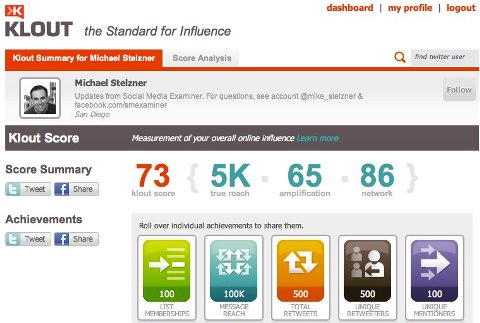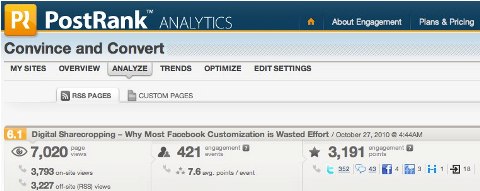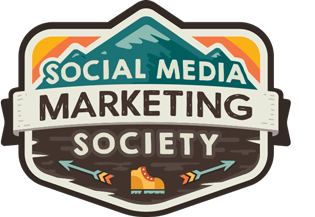 People who say social media isn’t measurable aren’t looking very hard.
People who say social media isn’t measurable aren’t looking very hard.
The truth is there are dozens of viable metrics you can use to gauge the success of your social media efforts. The challenge isn’t measurability; it’s knowing which measures are meaningful.
Here are the 6 undervalued social media success metrics you should be tracking:
#1: Daily Story Feedback
Instead of just counting the number of Facebook “likes” you accrue, which signifies nothing more than digital bumper-stickering, track how often your fans click “like” and comment on the status updates you post.
The more fans who click “like” and comment, the more likely your future updates will be seen in their news feed, dramatically increasing your actual Facebook audience.
If you’re an administrator of a Facebook fan page, you can find the Daily Story Feedback chart at http://facebook.com/insights (look in the Interactions category).
#2: Look at Klout
Rather than paying rapt attention to the number of Twitter followers you’ve corralled, instead look closely at your Klout score.
Klout is an online influence gauge that combines several data points (followers, retweets, clicks on links, etc.) and then applies some fancy algorithmic voodoo to arrive at a unified metric.
The data used to calculate Klout continues to change (they recently added Facebook information), but I’ve found it to be the most reliable influence-tracking metric, because it’s nearly impossible to “game” using automated follow-back programs and other Twitter nefariousness.

#3: PostRank
One of the challenges of writing a blog is knowing how to value the wide variety of reader engagements and behaviors. Should you care more about Digg submission than about comments? Are tweets more important than Facebook shares?
PostRank Analytics solves this problem.
It’s free if you connect with their “influencers” outreach program or $15/month if you don’t. PostRank provides a useful, detailed blogging scoreboard, especially if you connect it with your Google Analytics account.
The best part of PostRank Analytics is the engagement score, which is sort of your Klout score for each blog post. The system looks at total comments, tweets, shares, etc. for each post and applies behavior points and an algorithm to determine the total score. This is a fantastic way to look at your last 25 blog posts to see which type of content you’re publishing generates the most engagement. The image below is a recent post on Convince & Convert .

#4: Share of Voice
Tracking how often your company and/or its products are mentioned on the social web is a best practice, of course. But without also paying attention to how often your competitors are referenced, it’s difficult to determine whether the chatter about your brand is significant.
Get World-Class Marketing Training — All Year Long!
Are you facing doubt, uncertainty, or overwhelm? The Social Media Marketing Society can help.
Each month, you’ll receive training from trusted marketing experts, covering everything from AI to organic social marketing. When you join, you’ll also get immediate access to:
- A library of 100+ marketing trainings
- A community of like-minded marketers
- Monthly online community meetups
- Relevant news and trends updates

Discover Proven Marketing Strategies and Tips
Want to go even deeper with your marketing? Check out the Social Media Marketing Podcast! Publishing weekly since 2012, the Social Media Marketing Podcast helps you navigate the constantly changing marketing jungle, with expert interviews from marketing pros.
But don’t let the name fool you. This show is about a lot more than just social media marketing. With over 600 episodes and millions of downloads each year, this show has been a trusted source for marketers for well over a decade.
To add a reference point to your social mention tracking, create a “share of voice” report.
To do so, determine the number of times your company and its products are mentioned on the social web in a neutral or positive context over a 30-day period. You’ll want to use Radian6, ViralHeat, Social Mention or any of the other social listening tools for this project. Then determine how often your competitors are mentioned (neutral or positive) during the same 30 days.
Add up all mentions for the category (you plus your competitors), and then divide your mentions by the total to calculate your “share of voice”—which is always a percentage. Usually, share of voice reports are formatted as a pie chart, so you can easily see how you fare versus your competition.
#5: Search Volume
Perhaps more than any other marketing metric, the number of people who are searching for your brand on Google serves as a catch-all metric for market awareness.
In many ways, social media and your other marketing efforts create demand, which is then harvested via searches.
The tie between search and social media cannot be overestimated. Perhaps the best study on the subject, from GroupM in 2009, found that consumers exposed to a brand in social media are subsequently 2.8 times more likely to search for that brand than are consumers unexposed within social media.
Use Google Insights to examine whether searches for your company and products are increasing over time, and if your volume is going up, and your competitors’ isn’t – double bonus!
#6: Inbound Links
Without other sites linking to your website, it’s highly unlikely you’ll ever crack the Top 10 in Google. Links are the coin of the realm in SEO, and without them all you have is a pile of carefully crafted words.
Social media is one of the best places to accrue links, because we social types are prone to link from our tweets, Facebook updates, blog posts, within blog comments, etc.
Track the number of links pointing to your website and/or blog, and examine the source of new links. How many links do you have, in comparison to your competitors? What sites are linking to them that perhaps you could get to link to you as well?
There are several inbound link-tracking services online. My favorite is Open Site Explorer from SEOmoz. The free version allows you to track and report on up to 1,000 links.

If you’re looking for a magic number that automatically determines your social media prowess, you’re not going to find it. Instead, the secret to tracking social media is tying together disparate data sources and selecting the metrics that make the most sense for your company. And those are never the obvious ones like Facebook fans and Twitter followers. Tracking social media may not always be easy and fast, but it’s absolutely, 100% doable.
If you’re interested in more on this subject, my new book, The NOW Revolution (written with Amber Naslund) has an entire chapter devoted to metrics and how to pick the right ones.
What are your thoughts? Have you employed any of these metrics? Leave your comments in the box below.
Attention Agency Owners, Brand Marketers, and Consultants

Introducing the Marketing Agency Show–our newest podcast designed to explore the struggles of agency marketers.
Join show host and agency owner, Brooke Sellas, as she interviews agency marketers and digs deep into their biggest challenges. Explore topics like navigating rough economic times, leveraging AI, service diversification, client acquisition, and much more.
Just pull up your favorite podcast app, search for Marketing Agency Show and start listening. Or click the button below for more information.

